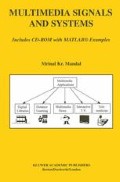Abstract
Communication technology has always had a great impact on modern society. In the pre-computer age, newspaper, radio, television, and cinema were the primary means of mass communication. When personal computers were introduced in the early 1980s, very few people imagined their tremendous influence on our daily lives. But, with the technological support from network engineers, global information sharing suddenly became feasible through the now ubiquitous World Wide Web. Today, for people to exploit efficiently the computer’s potential, they must present their information in a medium that maximizes their work. In addition, their information presentation should be efficiently structured for storage, transmission, and retrieval applications. In order to achieve these goals, the field of multimedia research is now crucial.
Access this chapter
Tax calculation will be finalised at checkout
Purchases are for personal use only
Preview
Unable to display preview. Download preview PDF.
References
R. Steinmatz and K. Nahrstedt, Multimedia: Computing, Communications and Applications, Prentice Hall, 1996.
B. Furht, S. W. Smoliar, and H. Zhang, Video and Image Processing in Multimedia Systems, Kluwer Academic Publishers, 1995.
N. Chapman and J. Chapman, Digital Multimedia, John Wiley & Sons, 2000.
W. L. Rosch, Multimedia Bible, SAMS Publishing, Indianapolis, 1995.
K. Dowd, C. R. Severance, M. Loukides, High Performance Computing, O&Reilly & Associates, 2nd edition, August 1998.
C. E. Kozyrakis and D. A. Patterson, “A new direction for computer architecture research,” IEEE Computer, pp. 24-32, Nov 1998.
A. Silberschatz, P. B. Galvin, and G. Gagne, Operating System Concepts, John Wiley & Sons, 6th Edition, 2001.
B. Prince, Emerging memories: technologies and trends, Kluwer Academic Publishers, Boston, 2002.
V. Castelli and L. D. Bergman, Image Databases: Search and Retrieval of Digital Imagery, John Wiley & Sons, 2002.
F. Halsall, Multimedia Communications: Applications, Networks, Protocols, and Standards, Addison-Wesley Publishing, 2000.
T. N. Ryman, “Computers learn to smell and taste,” Expert Systems, Vol. 12, No. 2, pp. 157–161, May 1995.
Author information
Authors and Affiliations
Rights and permissions
Copyright information
© 2003 Springer Science+Business Media New York
About this chapter
Cite this chapter
Mandal, M.K. (2003). Introduction. In: Multimedia Signals and Systems. The Springer International Series in Engineering and Computer Science, vol 716. Springer, Boston, MA. https://doi.org/10.1007/978-1-4615-0265-4_1
Download citation
DOI: https://doi.org/10.1007/978-1-4615-0265-4_1
Publisher Name: Springer, Boston, MA
Print ISBN: 978-1-4613-4994-5
Online ISBN: 978-1-4615-0265-4
eBook Packages: Springer Book Archive

